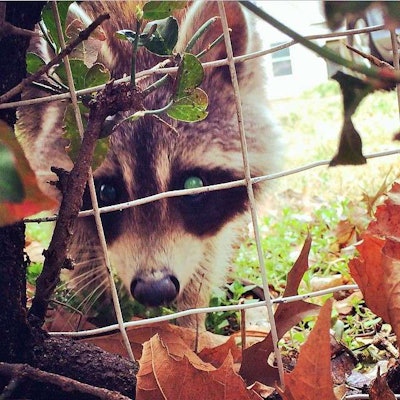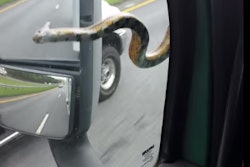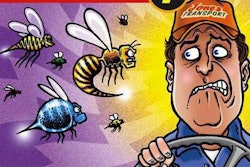
Pamela Boehland, in public affairs with the U.S. Department of Agriculture, shared the story of a recent instance of wildlife hitchhiking in a dry van full of auto parts that caught my eye for a variety of reasons. Chief among them was the difficulty such beasts — in this case, potentially rabies-carrying raccoons, but also foxes, skunks, bats and others — present to local biologists and others hard at work inoculating wild populations against viruses that can affect both animal and human populations.
The raccoon can certainly be “a charismatic species,” Boehland notes. (The picture above comes from my wife’s phone, captured one particularly memorable day last year around my home in Nashville.) But their accidental transport over long distances can break through the local/regional oral rabies vaccine barriers the USDA’s National Rabies Management program establishes by distributing vaccine baits in wild areas where rabies prevalence among carriers is known.
The Canadian provincial governments do the same in close collaboration with the U.S. program, notes Senior Wildlife Research Technician Tore Buchanan, of the Ontario Ministry of Natural Resources and Forestry. Buchanan tells the story particularly of a raccoon that earlier this year hopped aboard a trucker’s rig at an automotive warehouse in Hebron, Ky., where the potential for rabies-carrying raccoons is known. The doors to the trailer had been “open overnight, then closed up and driven to Mississauga,” in the Toronto area, says Buchanan. “When the driver opened up the doors again, the raccoon came out of the tractor-trailer and into the [receiving] warehouse.”

The driver on the scene, Buchanan says, knew enough about the rabies-vaccination programs to call “a local animal-control operator” to trap the animal and have it tested.
Such procedures could “be applicable for all different species of animals,” Buchanan says. Introducing species to new areas could break through local resistance to other diseases as animals are exposed to “genetically different” variations on those diseases, too. In the case of this raccoon from Kentucky, he adds, it wasn’t rabid, but rather “tested positive for both canine distemper and parvovirus,” serious diseases themselves.
Buchanan says such a “translocation” of a raccoon could be responsible for the return of Eastern U.S. raccoon-strain rabies to the province this past December. Ontario never saw the raccoon-strain rabies common in the Eastern United States “until 1999,” and the province “eliminated it in 2006,” then going 10 years without any reported cases in Ontario. “We had our first case again in Hamilton in December of 2015, and we might speculate it was a translocation.”
If you see a stowaway/hitchhiker in your truck or trailer, Buchanan advises, “without putting yourself at risk, contact a municipal animal control or professional nuisance-wildlife guy,” who ought to know enough depending on the local situation whether trapping and testing is warranted.
“They might contact the provincial or state wildlife agency then,” Buchanan says. “We assume the incidence of this is under-reported.” If more instances of transport could be documented, the spread of rabies, the world’s most deadly virus, might better be contained.
This Kentucky raccoon “turned out not to be an issue,” Buchanan adds, and it’s the only one they’ve “thoroughly documented” from a truck situation. “We’d like to document these kinds of cases – and utilize that information in our rabies-control program.”
Read more about USDA’s rabies-vaccination program at this link. Ontario’s program is detailed here.









